|
Growing up Asian in the Silicon Valley during the dot-com era, I was exposed to a lot of really good Chinese food. Be it at a local joint with the family after church, at a family friend's banquet wedding, or at a friends house for dinner, by the time I moved away from home, I had some very high standards for Chinese food, and really wanted to be able to reproduce it myself. 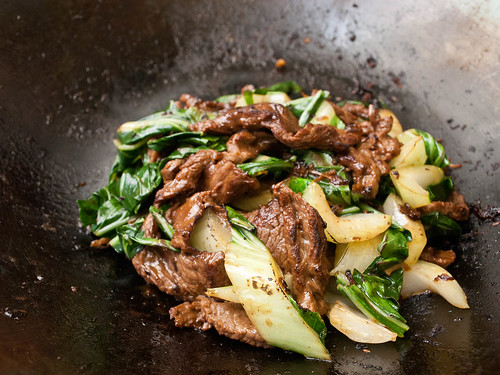 Recipes and guides in this thread (so far): Beef with Broccoli in Oyster Sauce Dan dan mian (spicy and numbing cold noodles) Dat Tat (Hong Kong Egg Custard Tarts) Di San Xian, stir fried potatoes, aubergine, and pepper Gailan and Preserved Ham La Rou Fan (Chinese bacon and rice bowl) Lo Bak Go, Cantonese turnip cake dim sum Ma po tofu, Gravity's guide Ma po tofu, Sjurygg's guide Numbing and Hot Cold Meats Red Braised Pork, (aka Mao's Red Braised Pork, Hunan Braised Pork) Roast Pork Belly (Siew Yuk) version 1 Roast Pork Belly (Siew Yuk) version 2 Salt and Pepper *stuff* Shu mai, Pork and Shrimp Dim Sum Steamed Dumplings Shredded pork with Sichuan Garlic Sauce (Yu Xiang Rou Si) Spicy Fish and Bean Curd Stick in Claypot Westlake Beef Soup Zha Jiang Mian (Fried Sauce Noodles) Blog links from Kritzkreig Kop: Spicy Cold Noodles Red-Cooked Spareribs (紅燒排骨 Hong Shao Pai Gu) Green Onion Pancakes Cumin Pork Spicy eggplant Tang Yuan 汤圆 (Glutinous Rice Balls) The Pantry: Light soy sauce Most soy you buy in grocery stores is sort of halfway between a light and dark soy based more closely on a Japanese variety, a sort of jack of all trades master of none, soy. There really is a noticeable difference between light and dark soys. Light soys are thinner and are used mostly for adding salt and “umami” without adding color, great for light gravies, chicken or seafood dishes, or for dipping. It is a younger soy and the best quality ones (Touchōu) will come from a first pressing, very similar to extra virgin oils. Swirling a bottle will not result in heavy coating of the glass. Dark soy sauce Dark soy is an older, thicker soy. It usually has molasses added. Swirling a bottle will result in coloration and coating of the glass walls. It is usually added to beef and pork dishes due to its richer flavor and darker coloring. for both light and dark soy I like Pearl River Bridge brand Oyster sauce 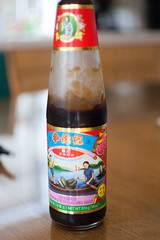 A dark, viscous, savory sauce made from oysters. Used a lot in stir frys. Toasted sesame oil An aromatic flavoring oil usually used to finish a dish. Chili sesame oil Sesame oil infused with chilies. XO sauce A relative newcomer to Chinese cuisine. XO sauce is indicative of the Hong Kong style cooking. It is comprised of dried seafood such as abalone, scallops, and shrimp, cooked with chilies and aromatics in oil. It can be made at home, as well as bought in a jar. I have not made it myself, but plan to in the future. Due to the price of raw ingredients, most people may be better served buying it premade. Taste is salty, spicy, seafood-y. Fermented black beans Not to be confused with Latin American black beans, these are salted, fermented soy beans. Often comes in a jar or a can. Taste is sharp, salty, a bit pungent. You can also buy premixed “black bean sauce” but the flavor of these isn’t as good. Garlic chili paste 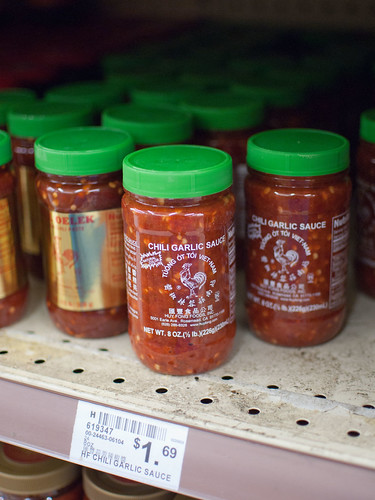 Or chili garlic sauce, it is a fairly spicy fresh chili paste with garlic (hence the name). Used a lot in Sichuan food, as well as a table condiment. It is very similar to Sambal Oelek and can be used interchangeably. Shaoxing rice wine Chinese cooking wine, usually added to marinades as it tames rough gamy or fishy flavors. Oft substituted with dry sherry, I find that it is worth hunting for. Sichuan flower pepper, prickly ash Contrary to the name, flower peppers are not related to peppercorns or capsicum in any way. They are a member of the ash family and are “hot” in a different manner than both peppercorns and capsicum. They are tongue numbing. Flavor notes are like rounded citrus tones. Star Anise A star shaped spice that is very similar to anise in flavor (go figure). “Five spice blend” A blend of cloves, star anise, flower pepper, fennel seeds, and cinnamon. Can be bought as a preground blend, but is much better if you use whole spices and grind fresh each time you need it. MSG Monosodium Glutamate. Makes Stuff Good. Contrary to what your crazy health nut aunt told you, MSG is no worse for you than salt. Also contrary to what she told you, they have also never conclusively shown that there is such thing as an MSG sensitivity. Wikipedia posted:While many people believe that monosodium glutamate (MSG) is the cause of these symptoms, an association has never been demonstrated under rigorously controlled conditions, even in studies with people who were convinced that they were sensitive to the compound. Yuxiang Like the French mirepoix, or the Spanish sofrito, the Chinese have an aromatic gastronomic trinity as well. Yuxiang consists of the blend of garlic, ginger, and scallions. In Sichuan food, the trinity is garlic, ginger, and chilies. The Wok The large, thin, carbon steel or cast iron cooking vessel of choice in much of Chinese cooking. Proper use of a wok implies face rippingly hot heat, therefore WOKS SHOULD NOT BE TEFLON COATED. Look for a wok that is thin and has a metal or wood handle, often welded or bolted to the wok body. Do not get a wok with a plastic handle. Woks are authentically round bottomed, however if you cannot use a wok ring, or must use an electric range, get a flat bottomed wok. Spergers will rant at you for it, but it's better than nothing, and certainly better than nonstick "woks". Like cast iron cookware, woks need to be seasoned. Watch this: https://www.youtube.com/watch?v=_SesaUVFZ-M. The surface chemistry of proper wok seasoning requires oil to plasticize on the surface. Some methods tell you to just swirl oil around in the wok, dump excess, and heat to high temp for long periods of time, but this method results in an uneven seasoning (it will eventually even out over time, though). The oils will bead and harden into droplet like structures on the surface of the pan. With the paper towel method, you are constantly redistributing the oil across the surface of the pan in a thin layer, preventing the droplets from forming. You aren't actually baking the paper into the wok. A properly seasoned wok, used correctly, will be moderately nonstick. Things wont slide around like an ice rink as on Teflon, but you should have some nonstick properties. Use the highest intensity heat source you can. Many gas ranges have a “quick boil” burner, use that. Those with electric ranges, you may want to consider buying an outdoor setup. One way to get around lack of power is to cook in smaller batches and in steps, being sure to fully heat up the wok between batches/steps. The Wok Spatula It is useful to have a proper wok spatula. They have longer handles and are made out of wood or metal. I like using wood ones. The bottom edge is curved like the bottom of a wok, and the surface area of the spoon section is large, allowing for efficient stirring. Bamboo Steamers You can also use your wok to steam. In order to do this you will need to pick up a bamboo steamer. They are pretty cheap at Asian markets. Unless you can get profuse amounts of steam, you really shouldn't stack these any higher than 2 or 3, as the temperature of the air/steam will drop the higher you go in the stack. Relatively recently, food celebrities warn against the use of bamboo steamers, worrying about cross contamination. I say they are just being dumb. Bamboo steamers in use are constantly full of 212F steam, and you should be washing them afterwards. Just spray down with a star san solution after, wipe it down, and let it dry. Techniques Slicing meat thin When I was learning how to cook Chinese food, one of the first things I had to figure out was how to get meat sliced thinly. My favorite Chinese places growing up had meat that was nearly ribbon thin. As I started figuring out techniques and recipes, one thing that escaped me was how to get the meat as succulent as the best restaurants I’ve been to. One part of this succulence is cooking the meat as quickly as you can, achieved not only with infernal heat but with thinly slicing the meat as well (there are other tricks, too). In order to slice meat thin, place it in the freezer for half an hour to 45 min. The meat should be slushy and hard, but still pliable, and not frozen through. Then use a cleaver and slice against the grain. The usual marinade Many stir fried meat dishes start out the same way. Slice meat thinly then marinate in a mixture of shaoxing wine, light (or dark) soy, sesame oil, cornstarch, a bit of baking soda (optional), and minced garlic and ginger. Baking soda is optional. It helps to tenderize the meat. I only use it with tougher cuts of beef and pork, I don't bother with tender cuts or chicken and seafood. The meat should not be swimming in marinade, actually, it should be quite dry. I never measure this step, but if I had to just estimate right now, for about a half pound of meat I’d say: 1 tsp cornstarch, a pinch of baking soda (if used), a small splash of soy, small splash of sesame, small splash of shaoxing, 1 minced clove garlic and an equal size piece of ginger, minced. If you are cooking chicken or seafood, use light soy. Use dark for beef and pork. Mix through. Marinate for 15-30 min. Mise en place A French term meaning “everything in place,” I would say that it is one of the most important things to making good Chinese food. Mise en place in this context means to have all of the ingredients for a certain dish prepped and chopped and ready to be cooked, all easily accessible and within reach before you even start heating the wok. Many stir fried dishes should take less than 3 minutes to make once you start cooking. Stopping to chop something or find a bottle of sauce could prove to be detrimental to your attempt. I go so far as to take all the lids off the bottles and jars and put spoons in the jars before I start cooking, so I don’t have to leave the wok at all. Ready…set…go! The usual method Fire it up! Turn on your hood vent. Put a dry wok on a burner set to its highest setting. Let it heat up. It will smoke. It may even start to glow red. That is fine. When ready to cook add a neutral oil like grapeseed, canola, or peanut. Do not be shy. Swirl in wok. It, too, will begin to ripple and smoke almost instantly. Place meat into wok, distributing across the bottom into a small layer and let sear for a little bit. Scrape your wooden or metal spatula across the bottom to dislodge all the meat. With your other hand, toss the meat with the wok using flick of the wrist. Repeat until meat is mid rare. Depending on heat source intensity, you may want to pause in between tossing to get some char. You may also want to reserve the meat and let the wok get hot again before moving on. Add fleshy vegetables like onions, bell peppers, etc. Repeat tossing motion. Veg should be cooked through, but should still be very toothsome. If you reserved meat, reserve veg, too and bring the wok back up to smoking temperature. Replace both meat and veg. Add sauces. Toss. Add leafy veg like cilantro, scallions, or chives. Toss. Serve. Keep trying and eventually you should look like this: https://www.youtube.com/watch?v=sYAew58LXkU&t=138s Cleaning the wok Cleaning a wok is easy. Put it on the heat, bring to excessive smoke point. Pour in about a cup of water. Swirl, scrape with spatula or use a bamboo brush: http://www.amazon.com/Pacific-Rim-Gourmet-Bamboo-Brush/dp/B0000CDHNC/ref=sr_1_1?ie=UTF8&s=kitchen&qid=1302021006&sr=1-1 This one is kind of pricey, I'm just posting it here so people know what it looks like. Go to Chinatown/Asian market, they're like 3bux. The bristles are rigid and will dislodge food, are soft enough to not damage the seasoning, and will not melt like plastic. Once the surface is smooth, dump water, put back on burner to dry thoroughly. Pour a bit of oil in pan and wipe entire surface with paper towel to distribute evenly. It is not important to cook in the oil, as with seasoning, but you just want to put a thin layer across the surface to prevent rust from forming in scratches that may have formed. Let the wok cool, and store. Like other cast iron cookware, never use soap on a wok, and for the love of all that is holy NEVER PUT A WOK IN THE DISHWASHER. I'll keep updating this thread with some recipes and ingredients as we move along, but this should be a good starting point. I'm by no means an expert, I just really love Chinese food, and love to cook, and like to think I've got a good grasp on a lot of the techniques. I would love to see your recipes and techniques here, too. GrAviTy84 fucked around with this message at 06:05 on Aug 10, 2013 |
|
|
|

|
| # ¿ Apr 27, 2024 05:46 |
|
King Bahamut posted:Nice OP! If you're going into recipes, are you taking requests? Anything regarding sichuan green beans or Chinese stock/soupmaking would be welcome Thanks! Yes, I've done dry fried yardlong beans before, and I can post it.
|
|
|
|
Gai lan and preserved ham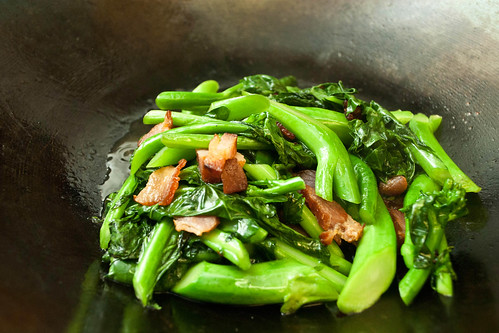 Ingredients: Gai lan Chinese bacon, ham, or sausage 1/4 cup chicken stock or water with 1 tsp brown sugar or palm sugar dissolved in and 1 tsp light soy Slice about a cup of gai lan (Chinese broccoli) into 3 inch long pieces at an angle. Thinly slice some Chinese bacon or Chinese ham (even Chinese sausage will work in a pinch). In a hot wok, add a small amount of oil, swirl, and add ham. Brown and add gai lan. Toss a few times and add the stock/water solution. Cover and cook until gai lan is cooked but still toothsome. Remove cover and let a bit of the liquid evaporate. Serve.
|
|
|
|
PRADA SLUT posted:Can I get a Wok recommendation? I had one years ago but I didn't really know how to use it and hosed it all up. I usually get mine at Asian markets. They're pretty good quality, though not the best. Sometimes, construction can be iffy. I gotta stress again to double check that it is not teflon coated, and that it should not have plastic handles. The handles should be either wood or metal or metal loops, and be welded or riveted on. branedotorg posted:Great OP though, what region would you say most of your food is based on? I'd guess cantonese from the ingredients. I'd say, yes, mostly Cantonese, though I've cooked a few "standards" from other regions, especially from Sichuan province, and most recently (relatively), Taiwanese. I hope to attack dim sum in this thread, too, as it is one of my biggest comfort foods. mmmm...chicken feet. GrAviTy84 fucked around with this message at 16:48 on Apr 3, 2011 |
|
|
|
mindphlux posted:op - was ready to troll the heck out of this thread becuase "chinese" "food" is such a broad and elusive topic, but great OP, I learned a few things. (baking soda?) Yeah, I realize it's kind of a broad term, but I kind of want it to be a broad thread. I would love to learn how to cook other styles as well, and I don't have the desire to be the only contributor, let's call this a Chinese multi-provincial collaboration thread, managed by a dude who cooks Cantonese food pretty well. I'll add a little bit about why baking soda to the op. branedotorg posted:For the record I'm a white australian who manages a bar with a very authentic thai kitchen & i've done about 5-6 days of 'foodie tourism' level chinese cooking classes in china in the ghangzhou, shenzhen & haikou provinces. I've also been cooking sichaun food at home for about 7-8 years with a little help from books & some people i've met through authentic local joints. Awesome, I'd love to try some of your recipes and tricks.
|
|
|
|
Shredded pork with garlic sauce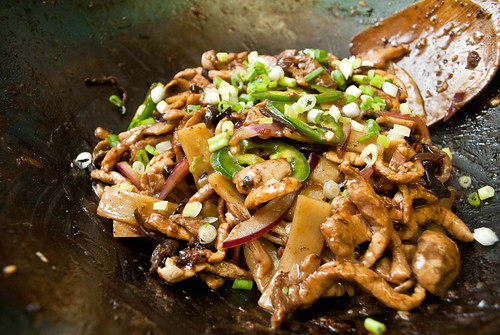 I think it's also called "yuxiang rousi," or fish fragrant pork (though it has no fish in it). One of my favorite dishes. I used to order this all the time at a cafe near my school during lunch back in high school. Spicy, savory, sour, and a tad sweet for balance, this Sichuan dish, also popular in Shanghai restaurants, takes a few times to get the balance "just right", but it is totally worth trying. Ingredients 1/2 lb pork cut thin, then into matchsticks, prepped in the usual marinade. 1 small onion or 1/2 large onion, sliced thin equal amount of wood ear fungus, sliced into ribbons equal amount of bamboo shoots, cut into matchsticks equal amount of peppers, cut into matchsticks, use a variety you are comfortable with the heat level of, I like using jalepenos minced ginger, garlic, thinly sliced scallions chili or sesame oil for finishing Sauce: 2 tbsp light soy 2 tbsp Chinese black vinegar, or red wine or white vinegar if you don't have black vinegar, use dark brown sugar if you substitute. 2 tbsp sugar 1 tbsp Shaoxing wine 2 tsp cornstarch dash white pepper 1 tbsp or to taste, garlic chili paste pinch MSG Prep ingredients. In a bowl or cup, mix sauce ingredients. Heat wok, add pork, cook till mid rare. If underpowered, reserve, and bring wok back to high temp. Cook vegetables except scallions. Replace pork if reserved. Add sauce. Heat till thickened, add scallions and a drizzle of chili or sesame oil. Toss through. Serve. Variations: The veg I use here is my favorite combination for this dish, but I've seen places use water chestnuts, baby corn, sliced mushrooms, and even celery in addition to or instead of certain ingredients. I don't care for celery versions. The biggest thing in getting this dish down is learning the proper balance of vinegar to sugar to heat to salt. You can also use this sauce with eggplant and/or deep fried tofu. Edit: I like a lot of sauce when I make this as I really like it on steamed rice. This recipe may be a bit heavy on the sauce for some, so you may want to start with about 3/4's as much sauce. mich posted:I made the fish fragrant pork yesterday and it was delicious! The amount of sauce was a bit much for my taste so in my second batch I used half as much sauce and then mixed the two batches together and it was perfect. Thanks so much for the recipe. GrAviTy84 fucked around with this message at 02:31 on Apr 15, 2011 |
|
|
|
mindphlux posted:Sorry, didn't realize. I think turkey fryers are the go-to portable wok burners. The gas is pretty reasonably priced, and you can usually pick one up for about 40-50 either online or at target or something. Pretty sound investment, they're also great for frying a bunch of stuff without stinking up your kitchen. Yeah, turkey fryers are a pretty good way to go. You can also use them for homebrewing beer. Bertrand Hustle posted:So I'd have to use it outside? I mean, I guess I could do all my prep inside and lug everything outside to cook, but it seems like a bit of a hassle. Get a tray, put prepped stuff on tray. It's no more of a hassle than grilling.
|
|
|
|
I am aware of and have XO sauce in my pantry. I mentioned it in the OP:GrAviTy84 posted:XO sauce Hollis Brown posted:GrAviTy84/anyone else- You can use tenderloin, loin, or even shoulder. Just make sure you slice thin, no big chunks. GrAviTy84 fucked around with this message at 07:21 on Apr 5, 2011 |
|
|
|
PorkFat posted:Would you rather have your food taste like food or burnt paper? You can use paper or onion or whatever, it's not really that big of a deal, you're burning the poo poo out of the stuff either way, you wont be able to tell what was in there before. The most important thing is the use of oil. Don't just put an onion in there. The surface chemistry of proper wok seasoning requires oil to plasticize on the surface. Some methods tell you to just swirl oil around in the wok, dump excess, and heat to high temp for long periods of time, but this method results in an uneven seasoning (it will eventually even out over time, though). The oils will bead and harden into droplet like structures on the surface of the pan. With the paper towel method, you are constantly redistributing the oil across the surface of the pan in a thin layer, preventing the droplets from forming. You aren't actually baking the paper into the wok. I think you're using too much marinade. It should be quite dry. You should only be using enough to coat the amount of meat you are using. There should not be any excess. Cleaning a wok is easy. You might know some of this, but I'll post a whole shpeal for those that don't. Put it on the heat, bring to excessive smoke point. Pour in about a cup of water. Swirl, scrape with spatula or use a bamboo brush: http://www.amazon.com/Pacific-Rim-Gourmet-Bamboo-Brush/dp/B0000CDHNC/ref=sr_1_1?ie=UTF8&s=kitchen&qid=1302021006&sr=1-1 This one is kind of pricey. Go to Chinatown, they're like 3bux. The bristles are rigid and will dislodge food, are soft enough to not damage the seasoning, and will not melt like plastic. Once the surface is smooth, dump water, put back on burner to dry thoroughly. Pour a bit of oil in pan and wipe entire surface with paper towel to distribute evenly. It is not important to cook in the oil, as with seasoning, but you just want to put a thin layer across the surface to prevent rust from forming in scratches that may have formed. Let the wok cool, and store. Edit: I'm going to add some of this stuff to the OP.
|
|
|
|
PorkFat posted:Thanks, I'll look harder for a bamboo brush the next time I go to the city. I can't find one around here and I'm not going to spend $10 on Amazon. I had one before with another wok, which is the wok I used the oil-only method of seasoning. And yeah, it did bead up and have little blobs on it like you said. I should have kept it but my drat room mate put it in the dishwasher when I was out of town. Did the same thing with my Lodge skillet because "it was greasy looking." Oh yeah. That's a point I forgot to mention, thanks. I'll put it in the op. "don't use soap or put in dishwasher."
|
|
|
|
Stalizard posted:Do you know any way to come close to replicating the basic brown sauce that comes in most takeout Chinese food, such as beef with broccoli? I've tried recreating it before and come pretty close, mostly I used beef stock, oyster sauce, soy sauce and some sugar/salt/MSG. It's just oyster sauce, light and dark soy, sugar, Shaoxing wine, corn starch, white pepper, sesame oil. If you can't get it to taste right, the thing you might actually be perceiving as missing is the flavor of "wok hei."
|
|
|
|
PorkFat posted:If you did use a ring - regardless of gas or electric - make drat sure it's a steel wire ring and not the ones made of sheet metal with round holes punched out. The sheet metal ones will trap heat and destroy the enamel on the stove top. If you have a glass top, you're out of luck - get an outdoor burner. Yeah, I've seen those shabu shabu burners at Asian markets, they're usually about 25bux give or take. IMO people are better served spending the extra  and getting FGM's suggestion. Especially if you already have a LP tank for a grill. and getting FGM's suggestion. Especially if you already have a LP tank for a grill.
|
|
|
|
Pork and Shrimp Shumai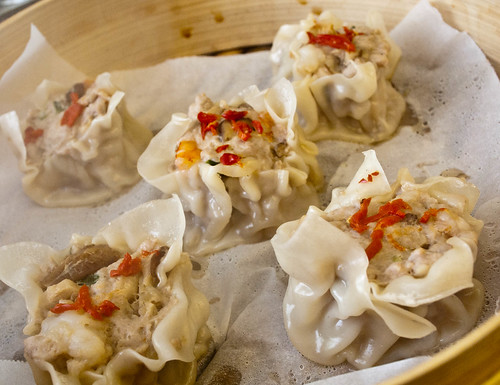 The ubiquitous dim sum dumpling. Usually made with pork, shrimp, and mushrooms, you sometimes see it made from beef or chicken, though it's not very common, and not as good IMO. I usually use store bought wonton wrappers, but I have pretty recently acquired a pasta roller so I hope to update this recipe so that you can make it completely from scratch. I'm no master dim sum maker, this is just (roughly) how I do it. I'd love suggestions if any of you know ways to improve it. Save your shrimp shells and mushroom stems for stock. Ingredients: Wonton or gyoza wrappers, square or circle, doesn't really matter 1 lb ground pork, not too lean 1/4 lb shrimp, any size, shelled, deveined, rough chopped in to small pieces, about .5 cm 2-3 shiitake mushrooms, stems removed, minced. Use fresh or rehydrated dried ones. 2 tbsp ginger, peeled, minced fine. 2 scallion, minced fine. 2 tbsp light soy 2 tsp Shaoxing wine 2 tsp sesame oil few dashes white pepper 1 medium egg, beaten 1 tbsp cornstarch salt Garnishes (optional): flying fish roe minced carrot minced red pepper peas pretty much anything, really Line bamboo steamer with parchment paper perforated with holes or lotus or banana leaf. Mix all ingredients but the wrappers together in a bowl. Take about 1 tbsp of the mixture and place in the middle of a wrapper. Cup the dumpling in one hand and bring edges up, pinching on either side to make the wrapper stick to the ball of filling, trying to prevent air pockets from forming. Pinch and form dumpling such that the top remains open and the filling comes just up to the top of the wrapper edge. Place in bamboo steamer, pressing bottom of dumpling on the steamer lightly to form a flat bottom. Steam for 5-10 min or until just cooked through, this will depend heavily on how much steam you can generate. Serve alone or with some garlic chili paste loosened in a bit of light soy. GrAviTy84 fucked around with this message at 01:17 on Apr 7, 2011 |
|
|
|
Westlake Beef Soup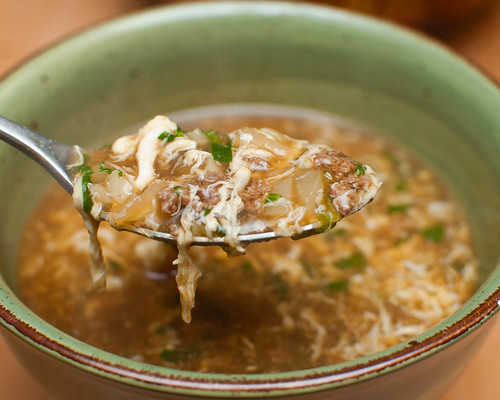 A very popular soup from the Zhejiang Province, Westlake Soup is a type of egg drop soup. It is very light with a silky texture nuanced with cilantro and white pepper. 1/4 lb lean beef minced fine then minced finer or lean ground beef, marinated in a bit of light soy, white pepper, Shaoxing, cornstarch, and a few drops of sesame oil for a few minutes. 1/4 lb silken tofu, diced into tiny cubes 2 shiitakes, fresh or rehydrated, stems removed, minced 4 water chestnuts, peeled and diced into small cubes, or a small handful of tinned water chestnuts drained and rinsed thoroughly, diced into small cubes 2 tsp ginger, peeled, minced fine or grated Beef or chicken stock, just a basic one, doesn't need too many aromatics just simmered, skimmed, and strained water, quartered onion, peppercorns, crushed garlic and bones, or store bought. About 4-5 cups 2 eggs, beaten Cornstarch slurry white pepper good handful cilantro leaves, minced 1 scallion, sliced thin This recipe doesn't really require ludicrous heat. On modestly high heat, brown and caramelize the beef. If using ground, break up into as small chunks as you can. Add ginger and shiitakes and saute for a bit until fragrant. Add beef broth. Add water chestnuts and tofu. Bring to rapid boil. Pour in enough cornstarch slurry to thicken to a thin gravy consistency. Pour in beaten eggs in a steady stream, stirring the surface of the soup with a fork to break up the egg stream into fine ribbons of cooked egg. Add a few dashes of white pepper, the cilantro and scallions, and taste for salt. Serve.
|
|
|
|
Ziir posted:Siew Yuk or Roast Pork AWESOME. Thanks for posting. The thread title was just a pun, I think this should be a thread for all kinds of Chinese foods.
|
|
|
|
Red Braised Pork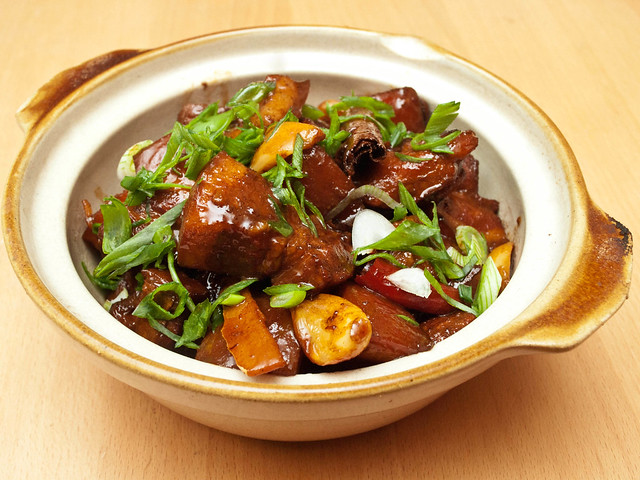 This is a classic dish from Hunan Province, sometimes called "Chairman Mao's Red Braised Pork" for supposedly being his favorite dish. My mom used to make this with short ribs, though classically it is made with belly, I believe. This is a recipe based on one in Fuschia Dunlop's Revolutionary Chinese Cookbook, I don't think hers is spicy enough, so I add more chilies, also I like the taste of a bit of dark soy added during my braise. Ingredients: 1 lb pork belly, you can also use spareribs or shoulder 2 tbsp neutral oil 2 tbsp sugar 1 tbsp Shaoxing wine 1 tbsp dark soy 1" piece fresh ginger, rough sliced 1 star anise 2 dried thai bird chilies (or more to taste, I use 4-5) 1.5" piece of cinnamon stick light soy sauce, salt, and sugar 1 scallion, minced Blanch pork in rapidly boiling water for about 5 min, remove and cool. Cut into bite size pieces. Heat oil in wok, add sugar, stir and caramelize until brown. Add pork, wine, soy, ginger, star anise, red chilies, cinnamon, and enough water to barely cover pork. Bring to a boil then reduce to a simmer, cover wok/pot and braise on low until tender (about 1.5-2 hrs). When tender, remove cover, turn heat up, and reduce liquid to a slightly viscous sauce. Should be able to slightly glaze the pork. Taste for salt and sugar. Top with minced scallions and serve. Variations: You can add fried water chestnuts, whole roasted garlic (the picture has this), fried tofu, or bean curd skin to the last segment of cooking. GrAviTy84 fucked around with this message at 04:55 on Apr 11, 2011 |
|
|
|
bewbies posted:Is that roast pork recipe from earlier the same thing as the delicious red BBQ pork you find at restaurants? If so I may try that next. No, you are thinking of char siu pork, which is usually pork shoulder, glazed in a mix of soy, hoisin, five spice, honey and/or maltose. The two roast pork (siu/siew is a phonetic spelling) recipes are for siew yuk which isn't as heavily seasoned as char siu, isn't sweet, and has the added factor of crispy crunchy skin. char siu is good, but well made siew yuk is better IMO. edit: Visual aid 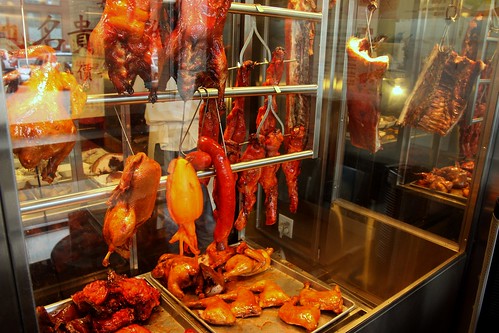 This is a typical window at a Cantonese "deli" upper left is roast duck, right down the middle is char siu, far right is the siew yuk. Other things, too, some poultry leg quarters on the bottom, cuttlefish, sausage, can't really tell the specifics about the other stuff because of the white balancing. 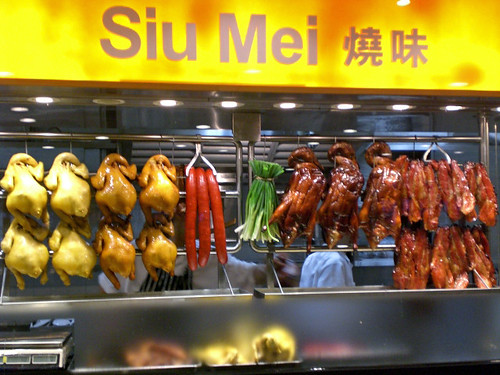 far left lightly seasoned steamed chicken next over is a soy glazed steamed chicken then sausages scallions, for some reason roast duck char siu The siu yuk is probably over a bit more, they can be quite big. GrAviTy84 fucked around with this message at 20:43 on Apr 11, 2011 |
|
|
|
Spicy Fish and Bean Curd Stick in Claypot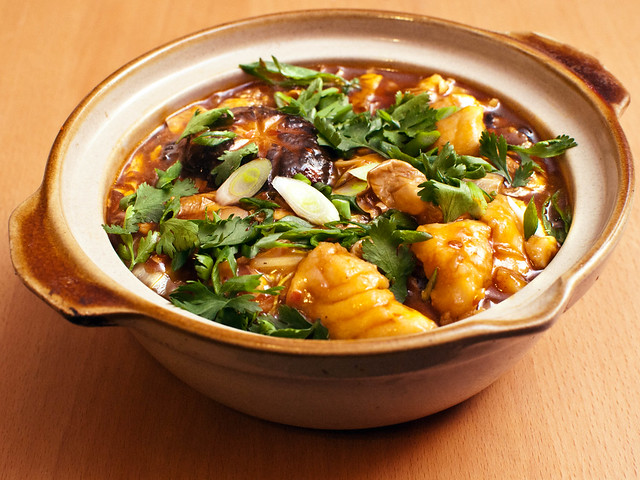 This is kind of a mashup of regional styles, but I really like it. Ingredients: 3/4 lb firm white fleshed fish, I like rock cod, sliced into 1/2 inch thick slices, marinated in a bit of Shaoxing wine, salt, and cornstarch (cornstarch optional, skip if you don't fry the fish) 1 tbsp ginger, minced fine 1 tbsp garlic, minced fine 1 scallion, sliced dried bean curd skin, soaked in hot water for 10 min 4 shiitake mushrooms, stems removed 3 leaves nappa cabbage, sliced into 1/2 inch ribbons light soy, to taste sugar, to taste cilantro leaves corn starch slurry Sauce: 2 cups basic broth, chicken or pork bone, or fish scraps simmered in water with a piece of crushed ginger and a few rough chopped scallions 1 heaping tablespoon Sichuan hot bean paste, or a few fermented black beans, lightly crushed/mashed in 1 tbsp of garlic chili sauce, loosened with a bit of dark soy and sesame oil. 1 tsp dark soy chili oil, to taste dash white pepper (Optional) Fry fish in hot wok with 1/2 cup of oil until medium. Reserve. Submerge clay pot in water for at least 15 min. In clay pot, heat about a tbsp of oil. Add garlic and ginger, saute until aromatic. Add sauce, mushrooms, and bean curd skin. Bring to a boil, taste for seasoning, adding light soy or sugar as necessary. Add nappa cabbage, cook through, add fish, heat through. Take care to stir gently after you add the fish, you don't want to obliterate the delicate meat. Add cornstarch slurry, enough to thicken to a medium thin gravy, stir through and bring back to a boil. Top with sliced scallions and cilantro leaves. GrAviTy84 fucked around with this message at 23:11 on Apr 11, 2011 |
|
|
|
Lo Bak Go (Turnip cake)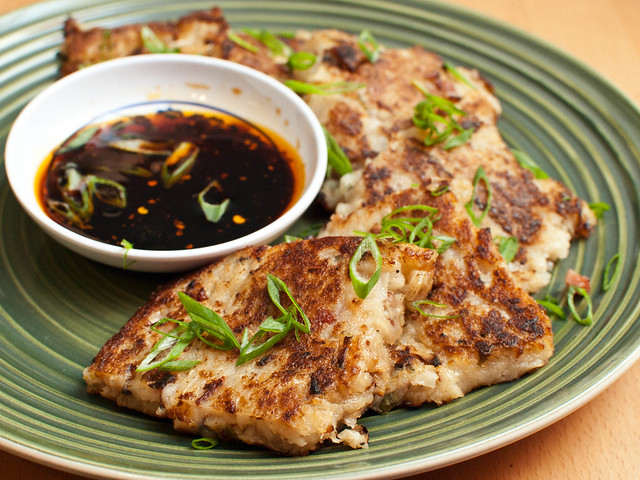 Often improperly named: "turnip cake," this dim sum dish is actually made with radishes, daikon to be specific. The cake is laced with bits of Chinese bacon, ham, or sausage, dried shrimp, shiitake mushrooms, and often scallions, and is steamed, then pan fried before serving. 1 large daikon radish (~2 lbs give or take), peeled, and run through the big holes in a box grater, or through your food processor's grating attachment. 6 shiitake mushrooms, stems removed, diced. If using dried, reserve liquid. 1/2 cup small dried shrimp, rough chopped, soaked in a bit of water. Just put them on your cutting board and make a few rocking passes with a cleaver. equal amount of Chinese bacon, minced. You can also use Chinese preserved ham or sausage, but bacon is best. 2 scallions, sliced 1 tbsp Shaoxing wine 2.5 cups rice flour, NOT glutinous rice flour salt 1 tsp sugar water In a big pot, add daikon and about a quart of water. Bring to a boil, reduce to a simmer, cook until tender, about 20-30 min. Drain and reserve both cooking liquid and grated daikon. Saute bacon in a pan until browned, add shrimp + liquid, and mushrooms and brown. Add to daikon along with Shaoxing, sugar, salt, and rice flour. Stir to combine. Add enough of the daikon cooking liquid to give the mixture a tapioca/rice pudding texture. Put mixture in a greased loaf pan. Place loaf pan in a pot of boiling water, cover, and steam for an hour. Remove loaf pan, cool, and chill over night in fridge. Run a butter knife along the edge of the loaf pan. Invert the loaf onto a cutting board and slice into 3/4" thick slices with a sharp knife and a slow and steady slicing motion. Fry in a pan on medium with some oil, flipping occasionally, until both sides are browned. I like to use a nonstick skillet for this last step. Serve topped with some sliced scallions and with some light soy and chili oil.
|
|
|
|
indoflaven posted:I applaud your effort, but what is daikon radish and chinese bacon? Any substitutes? Do you really not know what a daikon radish is? 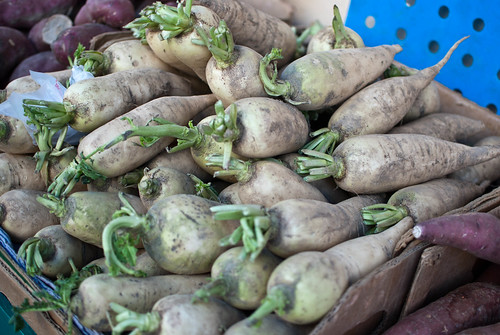 I guess you can use any other mild soft radish, like a white icicle or french breakfast radish, but really, it shouldn't be hard to find daikon. Chinese bacon is just spiced cured pork belly. 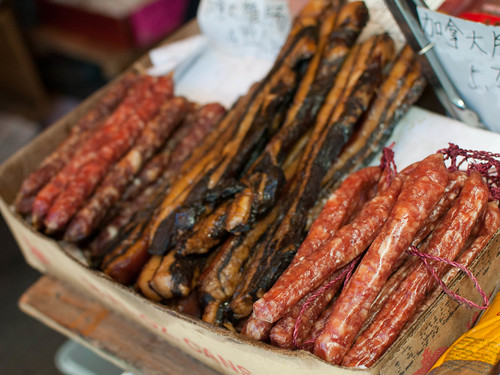 The one in the middle. They should have it at your local Chinese or Asian market. If not you can substitute Chinese preserved ham (not pictured) or Chinese sausage (pictured, on left and right of bacon), as I mentioned in the post. If you honestly can't get any of these, you can probably substitute regular bacon, fried crisp and glazed with some brown sugar. There are recipes for making your own Chinese bacon out there, but I haven't ever tried doing it. GrAviTy84 fucked around with this message at 10:11 on Apr 12, 2011 |
|
|
|
AriTheDog posted:Ooooh that looks really really good. I love turnip cake. Do you have a good recipe for chee chong fun/rice rolls/whatever they're called? I wish. Maybe one day I'll give it a try, looks tough. Edit: Of course I say this, then poke around the interwebs for a bit, then see this: http://www.youtube.com/watch?v=-OQlOYNo3wQ#t=1m
|
|
|
|
mich posted:I made the fish fragrant pork yesterday and it was delicious! The amount of sauce was a bit much for my taste so in my second batch I used half as much sauce and then mixed the two batches together and it was perfect. Thanks so much for the recipe. Glad it worked out. Yeah, I like mine pretty saucy to go on my steamed rice, but I'll amend the recipe with your suggestion for less sauce, thanks for the tips!
|
|
|
|
Hong Kong Egg Custard These little dessert tarts often seen on a dim sum cart are actually relatively new. Wiki says they started showing up around the 40's, and they bear striking resemblance to a Portuguese tart called "Pastel de nata." They are really great, light, not too sweet, delicious. Crust: 3 cups flour, sifted 1 1/2 sticks butter, cut into cubes warm water (5-6 tbsp) pinch of salt Custard filling: 3 Eggs 1 1/3 cup sugar 1 tsp vanilla extract 1 1/2 cups milk In a bowl or pyrex cup with a spout, beat eggs, mix in milk and vanilla, and dissolve sugar. Set aside. With dough cutter, cut butter into flour until mixture resembles pebbles. Gradually add warm water a tablespoon at a time until dough just barely comes together. Refrain from adding too much water. It should still feel quite fragile and should just barely hold itself together. Preheat oven to 425F. Dump onto a big work surface and lightly knead a few times to form a ball. Cut ball into halves and roll out to about a 1/4" thick. Grease tart molds, mini cupcake tins, or full size cupcake tins. Cut out an appropriately sized circle to line the inside of your mold of choice, if using full size cupcake molds, you may want to only go up about 2/3rds of the way up the wall. Pour filling into crusts and fill to about 1 mm below the top, a pyrex cup with spout is great for this. Place in the oven for 10 min. Then rotate the trays, reduce heat to 375F, and bake for another 10-15 minutes or until just barely set. As with all egg things, done in the pan means overdone on the plate so you want the centers to still be just a little bit wiggly but not runny. Pull them and cool in molds for about 10 min, then remove and cool on rack to room temperature.
|
|
|
|
Rurutia posted:Grav, between this and the dinner thread, I have the biggest crush on you. hehe thanks 
|
|
|
|
Dan Dan Mian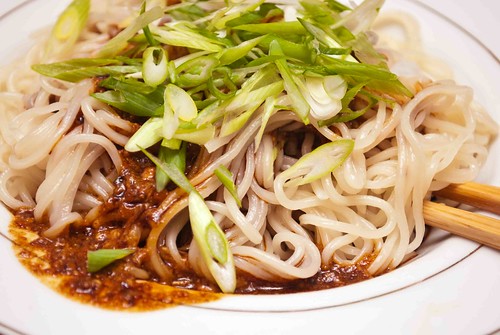 Named after the pole street vendors use to carry buckets of noodles and sauce around on, dan dan noodles are a staple of Sichuan province. There are many different versions, some are hot and soupy, some are room temperature or cold and just lightly sauced, some are anywhere in between. I prefer mine room temperature and heavily sauced but not swimming. Asian wheat noodles, fresh if you have access to them Sauce: 3 parts Light soy 3 parts Dark soy 3 parts Black Vinegar 3 parts Chili Oil 3 parts toasted sesame paste, or peanut butter 1 part sugar (Fuchsia Dunlop's version does not have sugar, I like adding it because I think it tastes more balanced.) 1 part sichuan peppercorn, toasted and ground Toppings (any or all of the following): Minced Sichuan pickled vegetables Sliced scallions cooked minced pork marinated in a little light soy Cook noodles, rinse in cool water, toss in a bit of sesame oil to keep separated. Top with sauce and toppings. You can make this hot and soupier with the addition of chicken broth. GrAviTy84 fucked around with this message at 22:08 on May 4, 2011 |
|
|
|
Cold Sliced Meats: Numbing and Hot One of the most popular Sichuan appetizers, usually served cold. Its sauce is really easy to make and can be served with anything from the beginner friendly chicken and turkey leftovers to braised beef shank, tendons, or tripe. 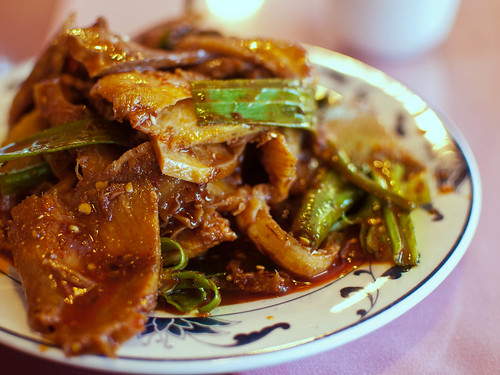 1 lb meat, poached or braised until tender in water with scallions and ginger, cooled and sliced thin, or into uniform chunks, reserve broth for another use 8 scallions, sliced thin, on a bias 1/2-1 tsp Sichuan peppercorns, depending on how numbing you want it, toasted and ground 4-5 tsp sugar (I like mine with 5) 3 tbsp light soy sauce 3-6 tbsp chili oil with chilies, 3 is usually plenty 2 tsp toasted sesame oil 1 clove, garlic, minced fine (I like mine with garlic) Salt to taste Dissolve sugar in soy, add the rest of the sauce in a bowl, add half of the sliced scallions. Making the sauce ahead of time will allow the flavors to meld. Drizzle over sliced meat and toss, top with scallions. You can also let this marinate for a few hours before serving. 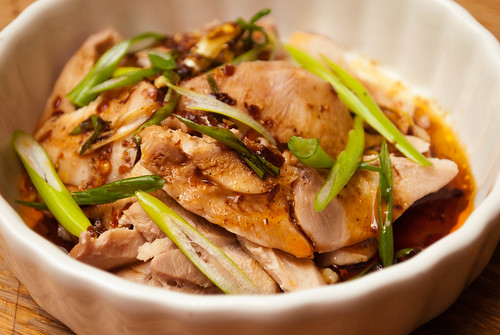
GrAviTy84 fucked around with this message at 08:52 on May 9, 2011 |
|
|
|
Salt and pepper (stuff)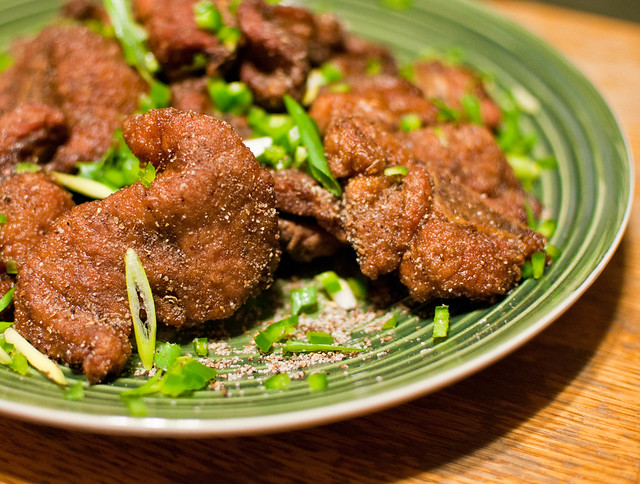 Seasoning: 1 tsp kosher or sea salt 1/2 tsp Sichuan peppercorns, toasted and ground 1/2 tsp black peppercorns, toasted and ground Garnish: Chopped hot peppers (jalapeno, serrano, or thai bird, up to you) scallions, sliced thin 1 lb pork: pork spare ribs cut against the rib into 1.5 inch lengths then cut again into cubes. pork shoulder steaks cut half inch thick then cut into manageable pieces pork loin sliced against grain into 1/4 to 1/2 inch thick slices  Sprinkle 1 tsp baking soda over pork and mix to coat each piece. Let it sit for 1 hour. Rinse off baking soda thoroughly, pat dry. Add 2 tsp dark soy to pork, stir to coat evenly. Dredge in corn starch. Fry in neutral oil at 375 F until golden brown. Drain. Season with salt mixture, top with garnishes, serve. Variations You can also do this with chicken wings, squid (cut into rings), firm fleshed white fish like cod (sliced into bite size pieces), head on shrimp, or the San Francisco favorite, Dungeness Crab (broken down into individual legs and body segments, dredged then fried). Skip the baking soda and soy treatment for these, just dredge in cornstarch, fry and top with salt mix and garnishes 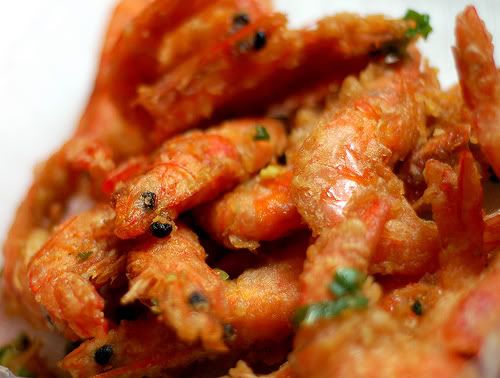  Vegetarians can also do this with tofu. Drain and press the tofu for 20 min or so. Cut into cubes, season with salt and a little bit of light soy. Let marinate for an hour or two. Drain then dredge in corn starch. Deep fry, top with salt mixture and pepper garnish. GrAviTy84 fucked around with this message at 23:43 on May 12, 2011 |
|
|
|
Hauki posted:What purpose does this serve exactly? I've never heard of doing that before. Tenderizes, gives the meat a sort of soft spongy texture. Good for making something like pork shoulder tender, even for only cooking for a minute or so.
|
|
|
|
bolo yeung posted:These look really good, and I'm thinking of making these this weekend. Do you have a recipe for a good veggie dumpling too? As in completely vegetarian? no. I think I've seen some filled with pea shoots sauteed with a bit of garlic, soy, and sesame oil. I believe these were wrapped in the tapioca starch wrapper like har gow. I've no experience working with that dough, but I'll post a recipe for the wrapper and you can try it if you like: quote:Dough I've watched videos of people making the wrappers. They form a ball, and use the side of a cleaver in a swooping motion across the cutting board to make a skin. http://www.youtube.com/watch?v=QS8hxtB8O6Q#t=2m50s http://www.youtube.com/watch?v=V73_npaaL4s I recall these pea shoot dumplings usually have shrimp in them, but maybe you can get away with just shiitake mushrooms. They are also closed differently. I think they are like little triangular shaped pouches. Ziir posted:Do you know a recipe for lo mai gai? No I don't. They are so cheap at local Asian markets and restaurants that I never bothered. I may try it sometime though, for the purposes of GrAviTy84 fucked around with this message at 22:59 on May 12, 2011 |
|
|
|
Sashimi posted:Just tried out this recipe and it turned out really well, thanks! Awesome, glad it worked out well. I think the proportions of filling to crust is really dependent on how thick you make the walls and the geometry of the molds you use. When I made these I had a little bit extra crust.
|
|
|
|
Fall posted:This sounds like a very mild version of the stuff inside zongzi and what we make at home, but still pretty tasty. What could really improve this is the addition of sticky rice (60:40 ratio of sticky:normal- beware of indigestion if you go too high) and a few other seasonings such as cooking wine, oyster sauce, sugar, sesame seeds, sugar and/or white pepper. Diced shiitake mushrooms are also nearly essential, not sure about greens in a rice cooker unless you do a quick stir-fry after cooking and add them in then. I'm not sure whether this recipe belongs in a wok thread (always use a rice cooker), but it's a tasty and easy recipe for anyone looking to replicate the flavour of zongzi. Light soy sauce isn't supposed to stain the sides of the glass. If he wants the glass staining, look into dark soy sauce. PRB makes a dark soy, too, and should be what you are looking for. I also prefer the taste of PRB, it just tastes better to me, I don't know how to describe it other than that, give it a try again.
|
|
|
|
Hey, I think I'll contribute to this thread again! Mapo Tofu 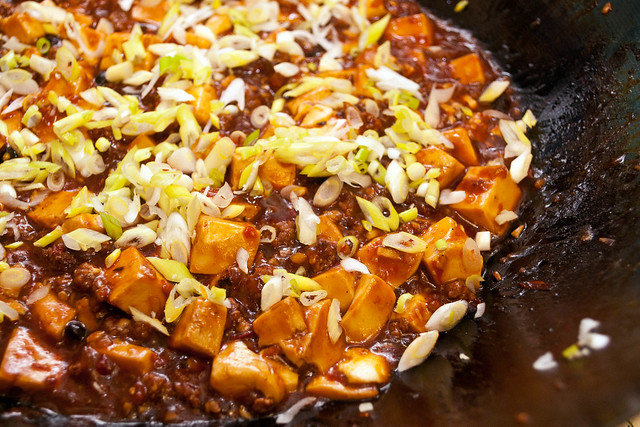 One of the most well known dishes out of Sichuan province, firey hot, aromatic, and absolutely delicious. If you think you don't like tofu, you've never had this before. I mostly follow Fuchsia Dunlop's recipe with a few changes that I will mark. Ingredients 1 block bean curd (She doesn't say what kind, I prefer silken for this application), cut into cubes 3 cloves garlic, minced equal amount of ginger, minced (she doesn't have either garlic or ginger, I think they are sorely missing from the recipe) 3 scallions, sliced thin on the bias 1/3 lb of beef (she says beef, I prefer pork) 2.5 tbsp Sichuan chili bean paste 1 tbsp fermented black beans, lightly crushed 1 cup stock of your choice, chicken is fine 1 tsp sugar 2 tsp light soy 1/2 tsp roasted Sichuan peppercorns, ground dash white pepper cornstarch slurry toasted sesame oil or chili oil (optional, she doesn't use it, I think it rounds out the dish a bit) 1 tbsp minced Sichuan pickled vegetables (optional, she doesn't use it, I think it brightens the dish considerably) ground dried hot peppers, to taste, I like about 2 or 3 ground chile japones (this is quite spicy) In a hot wok, add a bit of neutral oil, swirl. Heat till just barely smoking, add ground meat, stir fry breaking the mince into small clumps. Add garlic, ginger, sichuan peppercorn, ground chile, white pepper, and black beans stir and allow to get fragrant. Add bean paste, tofu, soy sauce, and stock. Bring to a boil, and add enough cornstarch slurry to make the sauce glaze the tofu. Serve garnished with scallions.
|
|
|
|
branedotorg posted:Silken is good although it should be poached to firm it up after cutting or it wont hold shape when folded in to the sauce. You just need to be more gentle.
|
|
|
|
Walk Away posted:Well, I guess that would be the obvious choice, but I was hoping to find something a little more novel that might broaden her horizons a bit. Get her to try gai lan (chinese broccoli). Steam some and top with oyster sauce and broccoli beef will lose all of its appeal.
|
|
|
|
Phiberoptik posted:Anyone have an egg tart recipe they would like to share? http://forums.somethingawful.com/showthread.php?threadid=3401971&userid=0&perpage=40&pagenumber=3#post390492515 There is an index of recipes posted so far in the OP.
|
|
|
|
I appreciate your contribution, but you realize you pretty much just stir fried vegetables with soy sauce. This is in no way unique or difficult, not only that but you were incredibly rude, which does not conform to whirled peas. Also, use or non use of Pinyin titles does not authenticate or negate the authenticity of a dish. Now, on to your recipe! There is more that one variety of eggplant! I know it's shocking but its true. The variety you are referring to is an Asian cultivar, they do sell them here in America. The larger ones you are thinking are the same cultivar are actually Italian eggplants and need to be salted and sweated before cooking. That is a really small knife. Are you sure this dish is authentic? A "REAL" Pinyin using Chinese person would use a gigantic cleaver. quote:Pour about half an inch of oil in the bottom of your wok. Turn the fire on *surface of the sun* or as hot as it will go. The wok should be heated to "surface of the sun" temperature *empty,* Only adding the oil once hot. Heating a wok with oil in it to the temperature of the sun is a bad idea quote:I'm not too GWS, but I think this is referred to as shallow frying (opposed to deep frying?) * is that a plastic handled wok? I can't tell if it's plastic or painted wood, but plastic handles with surface of the sun temperature woks is a bad idea.
|
|
|
|
porkypocky posted:Is it bad that I want to try this simply because I've never seen anyone stir fry a potato before? Not at all, my main gripe was that he came in here all smug and judgmental while only contributing the equivalent of a peanut butter and jelly sandwich on wonderbread. Editing to add content: I've had Chinese dishes with potatoes in them before, most were claypot style dishes, things like braised beef shanks with potatoes and nappa cabbage with black bean sauce. The potatoes are usually peeled, cubed, and deep fried before adding to the claypot. The stir fried potato dishes were prepped sort of like Aero's post, but would have a sauce with more than one dimension. GrAviTy84 fucked around with this message at 21:19 on Oct 26, 2011 |
|
|
|
Bauxite posted:HELP, I'M DUMB: depends, do you have fresh, parboiled, or dry noodles? fresh noodles will often be covered in flour to keep them from sticking, they need to be boiled, drained, and oiled before stirfrying dry noodles also need to be boiled, drained and oiled, but they need to be boiled longer. parboiled noodles will be coated in oil, they can be directly stir fried.
|
|
|
|
Bauxite posted:Maybe I'm being too rough with them, but whenever I get them into the wok it's like trying to saute pizza dough, they stretch or stick together and turn into a wet ball of mess. Does boiling fix that, or are shanghai noodles just supposed to be like that? Were they coated in flour in the package or were they shiny, bouncy, and taut, and possibly coated in oil? Assuming the former, you need to boil them. Assuming the latter, you might just need to do what porkfat suggested cover and steam them a bit and allow them to loosen. Any package instructions, by any chance? Can you take a picture of the package?
|
|
|
|

|
| # ¿ Apr 27, 2024 05:46 |
|
vxk5004 posted:If I wanted to make dumplings like you get at any Chinese restaurant, will the dim sum recipe earlier in the thread work or is there another option? There could be an entire megathread dedicated to Chinese dumplings. The shumai earlier is but one example. Which kind of dumplings are you trying to make? If I had to assume, I'd say you're looking for jiaozi. The filling is very similar to the filling in the shumai. The wrapping is different. I can write up more when I get home unless someone wants to address it before me.
|
|
|







 , following
, following